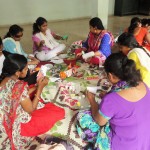Strengthen and Harmonize Research and Action on Migration (SHRAMIC) organised a half-day event on 13 February 2015 at the India Habitat Centre in New Delhi. Focusing on the theme of labour markets, the workshop brought together over 70 government officials, policymakers, NGOs, academicians, researchers, social entrepreneurs and corporations to focus on the role of labour markets in improving migration outcomes for the large number of labour migrants in India.
High cost of living traps migrant workers in Ghaziabad: Sahbhagi Shikshan Kendra
Circular migration in India is likely to grow, and the government, NGOs and other stakeholders must take steps to make it a more remunerative and less painful process for the poor. In this light, Sahbhagi Shikshan Kendra (Uttar Pradesh) undertook a study on the expenditure pattern and saving habits among construction workers, domestic workers, rickshaw pullers and pillow makers in Ghaziabad, as a part of their project: Reducing Vulnerability of Migrants at Source and Destination- with due focus on their rights, entitlements and access to services.
Birbal, a new initiative to help you help others: Agrasar
Innovation and creativity are key to social sector initiatives. For Agrasar, which is a not for profit organisation based in the National Capital Region, finding creative solutions that meet an immediate need has been an effective strategy. Agrasar operates 5 vocational training centres in Gurgaon, Saharanpur and Haridwar; however, our long-term interest is in providing solutions by which disadvantaged communities (like migrants) can access social services, with education as a priority.
Rights, capacity and control: Debating issues around the ability and willingness of cities to extend social services
The economic benefits of migration to the city is often offset by expenditure towards schooling, healthcare, food, sanitation and other services that the State is meant to provide.
Branding of Indian labour force
India is expected to be home to a skilled workforce of 500 million by 2022. About 12 million persons are expected to join the workforce every year. Till October ’14,the national skill development agency (NSDA) has been able to provide skill training to 31.52% of targeted population of about 10 million persons. In the backdrop, we have the Skill India initiative launched by the current government aims to train the youth with an emphasis on employment and entrepreneur skills.
Diversifying income sources for rural households: Assessments from 70th round of NSSO
The National Sample Survey Office (NSSO) has recently released, from its 70th round, key indicators on the situation of agricultural households in India. The results of the ‘Situation Assessment Survey of Agricultural Households in India’ pertain to the crop year 2012-13. For the fraternity interested in migration issues, this could be an interesting dataset to look at.
It’s a routine strategy under distress: PANI
Migration is a routine livelihoods strategy adopted in India and not simply response to shocks. People certainly do migrate because there is not enough work locally, but such migration should be understood as forced or distress migration because many people perceived migration as an opportunity.
Migration is a new age development challenge: Amrita Sharma (Aajeevika Bureau)
I have realized that in our villages, the youth are increasing disenchanted with farming occupation and are heading towards the city in pursuit of a better life. The stories of their search for a better future, however, do not always end well.
A life of uncertainty and instability: MMC
 Rohini was born in Chalisgaon, Maharastra but shortly thereafter her family moved to a construction site in Mumbai. She has been living on construction sites for as long as she can remember as the last three generations of her family have all been construction workers! For her, migration meant constant grappling with the feeling of uncertainty induced by frequent relocations, instability, and absence of solid support systems that would cripple her hopes, aspirations, and dreams. But 20 year old Rohini could have never imagined that her life would take a different turn…
Rohini was born in Chalisgaon, Maharastra but shortly thereafter her family moved to a construction site in Mumbai. She has been living on construction sites for as long as she can remember as the last three generations of her family have all been construction workers! For her, migration meant constant grappling with the feeling of uncertainty induced by frequent relocations, instability, and absence of solid support systems that would cripple her hopes, aspirations, and dreams. But 20 year old Rohini could have never imagined that her life would take a different turn…
When accidents evolves into crisis: JBVSS
In simple terms, a migrant is such person who leaves his/her native place and goes somewhere else in search of work/job only to return intermittently after certain time intervals like every three, six months, yearly or once in two years. That person while away from the native surroundings has to encounter several unforeseen situations which can put his life at risk. We as an entity of civil society, have tried to look deeper into the definition, knowing that the migrant has put the life at stake to earn an alternate livelihood and providing the necessary support services through Shramik Sahayta Evam Sandharbh Kendra (3SK).

